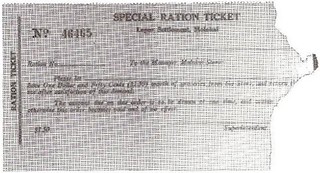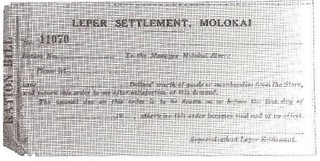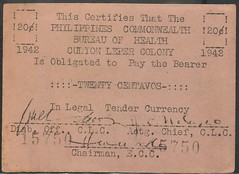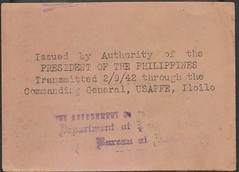
PREV ARTICLE
NEXT ARTICLE
FULL ISSUE
PREV FULL ISSUE
MORE ON THE KALAUPAPA LEPER COLONY
Wow - lots of The-Sylum readers are into Leper Colony tokens. My question last week resulted in a deluge of great responses.
-Editor
Ray Czahor writes: I have visited Kalaupapa Leper Colony in Hawaii. I am not aware of any tokens/coins issued for the leper colony there although there two types of ration tickets are known to be used in the stores there. Also there are a large number of medals issued commemorating the significant work by Father Damien at Kalaupapa in treating leprosy. The key work in this area is “The Numismatic Aspects of Leprosy/Money , Medals, and Miscellanea” by Roger R. Mcfadden, John Grost, and Dennis F. Marr published in 1993. It is hardcover, 167 pages with many photos. It is out of print but I have several new copies in stock. Coauthor John Grost writes: In researching the book "Numismatic Aspects of Leprosy: Money, Medals and Miscellanea " we could find no reference to tokens being used in Molokai. We did find a gasoline rationing chit, a special ration ticket store receipt, and a ration bill. see pages 32 -33. Roger Urce writes: To answer the question as to whether tokens were used in Hawaii at the Kalaupapa Leper Colony on the island of Molokai is no according to The Numismatic Aspects of Leprosy - Money, Medals, and Miscellanea by Roger R. McFadden, John Grost and Dennis F. Marr. According to the book, there were, however, two paper instruments reported to have been used. One is a Special Ration Ticket used as a type of letter of credit which could be spent by the person named thereon, and addressed "To the Manager Molokai Store" at the "Leper Settlement, Molokai' which was printed on the instrument. The ticket, described as being printed on light pink paper, was valued at $1.50. The second reported instrument is a Ration Bill which directed to the Molokai store manger. According to the text the bill "allowed the patient to have ________dollars worth of goods or merchandise from the store." The store manger was to return the bill to the Superintendent of the settlement once it was spent. There also bore a maturity date, after which it became void. This bill was printed on light blue paper, and like the special ration ticket, was serialized. Living conditions at the colony were "deplorable", and as reported, Father Damien, the patron saint of lepers, ministered to the patients between 1873 and his death from leprosy in 1889. The book, published by D.C. McDonald Associates, Inc (1993), is available on the Internet and contains a quite a lot of information on leper colony issues.
Ken Spindler of San Diego provided these images of the items from the Numismatic Aspects of Leprosy book. Thanks! -Editor

Special Ration Ticket Light Pink 
Special Ration Ticket Light Blue Ken Spindler adds: I used to have a rather extensive collection of token coinage of leper colonies, albeit it nothing from Hawaii. I exhibited my tokens in a few Southern California venues in 2006. My collection included multiple rarities and one K-M plate coin. Around the time of my exhibit I tracked down Dr. McFadden and corresponded with him briefly about the hoard of Brazilian tokens which hit the market back then. Dr. McFadden's collection of Philippine Exonumia was just auctioned off by Heritage in December 2014. In my 2006 exhibit I tried to connect to readers by pointing out: A leper colony in a tropical rainforest on a remote Amazon River island was featured in the 2004 release Motorcycle Diaries, about the medical school years of South American revolutionary Ernesto “Che” Guevara. The movie showed many real Hansen’s disease patients. You may also recall the character of the leprous king of Jerusalem, Baldwin IV, who was unmasked at death, in the 2005 film Kingdom of Heaven. To view the McFadden Collection, see:
Ken Berger writes: According to "The Numismatic Aspects of Leprosy" by McFadden, Grost & Marr, a Special Ration Ticket and a Special Ration Bill were issued for the Molokai Leper Colony. However, a 1919 letter from the superintendent of the Palo Seco Leper Colony in the Panama Canal Zone refers to a local currency used at the leper colony in Molokai. Perhaps he was referring to Special Ration Ticket/Bill mentioned above. Eventually, the U.S. did issue special tokens for the Palo Seco Leper Colony in the Panama Canal Zone. They were in the following denominations: one cent, five cents, ten cents, twenty-five cents, fifty cents & one dollar. All the tokens were the approximate size & thickness of the corresponding U.S. coins. The one & five cent coins were made of brass with a square hole, while the others were made of aluminum with a round hole. They were withdrawn from circulation in 1952 & destroyed by melting & dumping in the sea. It is estimated that only 4-5 complete sets exist. The late Harvey Rose of El Cajon had one of those sets &, I believe, Dr. McFadden also had a set at one time. Patrick Ian Perez writes: I read with interest the story you posted about the leper colony on Molokai. In 2008 I had the good fortune to visit the colony. At the time I was working at my Catholic parish in southern California which was staffed by priests of the Congregation of the Sacred Hearts, a religious order from which many of the original missionaries to Hawaii came from, including St. Damien of Molokai (most of which were Belgian). It was very special, because, as mentioned in the article you linked, the only way to be permitted into Kalaupapa is to be invited, and we were going as guests of the Order. The trip was very unique; we flew from Honolulu on a small plane to the airport on Molokai. From there, my friend and I got into a four seater, and it was just the two of us and the pilot (I got the front seat!). We took off, swung out along the coast of the island, and a few minutes later landed at the very small airstrip at Kalaupapa. We were greeted by a very old Belgian Father, filled out a fair amount of paperwork, and spent the rest of the day exploring the site. It was surreal and amazing, as aside from the three of us, there were only a few other workers scattered about, mostly at the post office they have there. Nothing but silence, the ocean, nature, and the buildings. Aside from the spiritual aspects, I did get to visit the small museum they have there with many letters, postcards and photographs, etc. I was specifically on the lookout for any type of banknotes, scrip, coins, tokens, etc. but there was none, except for (I think) an 1883 Hawaiian Quarter. The priest told me that the museum did house the Royal Order of King Kalakaua given to St. Damien (in 1881), but sadly it was stolen long ago. I kept thinking how many amazing items must be kept there, and how I wished I could catalog and organize them. The day ended as quickly as it started, and I was back in Honolulu shortly after sunset. To finally get around to your inquiry, I would say with near certainty that Kalaupapa did not have its own tokens or other circulating medium. Philippine Leper Colony Tokens and Scrip
Ray Czahor writes: The example “tokens” you mentioned are actually coins and except for the 1/2 Centavo, circulated heavily in the Philippines, not Hawaii. All denominations 1 Centavo through Peso were minted and circulated from the mid-teens through the 1930s. Also during WWII, seven denominations of emergency paper money was printed and issued in 1942. Patrick Ian Perez adds: I also attached a scan of a Philippines Culion Leper Colony 20 Centavo note from my collection since you posted some of the tokens.  
To read the earlier E-Sylum article, see:
Wayne Homren, Editor The Numismatic Bibliomania Society is a non-profit organization promoting numismatic literature. See our web site at coinbooks.org. To submit items for publication in The E-Sylum, write to the Editor at this address: whomren@gmail.com To subscribe go to: https://my.binhost.com/lists/listinfo/esylum All Rights Reserved. NBS Home Page Contact the NBS webmaster 
|